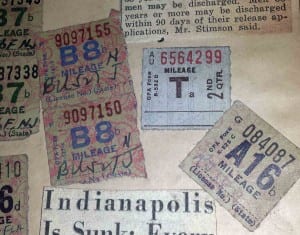The Reality of Rationing in World War II
The United States government asked the American public to make many sacrifices during World War II. One of the manifestations of this was rationing resources. Thus, ration stamps were soon a hot item throughout the United States.
In 1942 the Emergency Price Control Act granted the Office of Price Administration the ability to set price limits and ration food and other commodities. Thus, Americans were soon rationing coffee, cheese, fats, canned fish, canned milk, and even gasoline.
Americans received ration books that allowed them to buy a designated amount of a good so long as they would give over the stamp when purchasing that good. Hence, if a person has 5 stamps for 8 ounces of sugar each, then they they are limited to that (40 ounces total of sugar). Over ninety-one percent of the US population registered for these booklets during World War II.
In truth, an entire barter system was established. People would trade their stamps to one another leading to a ration stamp Black Market. Below are a set of ration stamps for gasoline. These stamps are in a scrapbook assembled by George Richter of Ridgewood, New Jersey. This scrapbook donated by George Richter’s son, Martin Richter, Lehigh University professor emeritus, and it contains a plethora of newspaper clippings and other World War II memorabilia. A guide (finding aid) to the scrapbook is created by Special Collections Collections student assistant Daniella Fodera, Class of 2018.
Interestingly enough, according to Wired magazine (This day in Tech: Dec. 1942: Mandatory Gas Rationing, Lots of Whining) there was no gasoline shortage. Rather, the United States government rationed gasoline to keep people from nonessential driving. This is because rubber was in high demand. The government wanted to limit the amount of car wheels being manufactured for consumers so that the excess rubber could go towards the war movement.

